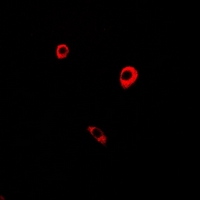Anti-CD85k Antibody
- SPECIFICATION
- CITATIONS
- PROTOCOLS
- BACKGROUND

Application
| WB, IF |
|---|---|
| Primary Accession | Q8NHJ6 |
| Reactivity | Human, Rat |
| Host | Rabbit |
| Clonality | Polyclonal |
| Calculated MW | 49356 Da |
| Gene ID | 11006 |
|---|---|
| Other Names | ILT3; LIR5; Leukocyte immunoglobulin-like receptor subfamily B member 4; CD85 antigen-like family member K; Immunoglobulin-like transcript 3; ILT-3; Leukocyte immunoglobulin-like receptor 5; LIR-5; Monocyte inhibitory receptor HM18; CD85k |
| Target/Specificity | KLH-conjugated synthetic peptide encompassing a sequence within the center region of human CD85k. The exact sequence is proprietary. |
| Dilution | WB~~1/500 - 1/1000 IF~~1/50 - 1/200 |
| Format | Liquid in 0.42% Potassium phosphate, 0.87% Sodium chloride, pH 7.3, 30% glycerol, and 0.09% (W/V) sodium azide. |
| Storage | Store at -20 °C.Stable for 12 months from date of receipt |
| Name | LILRB4 |
|---|---|
| Synonyms | ILT3, LIR5 |
| Function | Inhibitory receptor involved in the down-regulation of the immune response and the development of immune tolerance (PubMed:11875462). Receptor for FN1 (PubMed:34089617). Receptor for apolipoprotein APOE (PubMed:30333625). Receptor for ALCAM/CD166 (PubMed:29263213). Inhibits receptor-mediated phosphorylation of cellular proteins and mobilization of intracellular calcium ions (PubMed:9151699). Inhibits FCGR1A/CD64-mediated monocyte activation by inducing phosphatase-mediated down-regulation of the phosphorylation of multiple proteins including LCK, SYK, LAT and ERK, leading to a reduction in TNF production (PubMed:19833736). This inhibition of monocyte activation occurs at least in part via binding to FN1 (PubMed:34089617). Inhibits T cell proliferation, inducing anergy, suppressing the differentiation of IFNG-producing CD8+ cytotoxic T cells and enhancing the generation of CD8+ T suppressor cells (PubMed:16493035, PubMed:19833736, PubMed:29263213). Induces up- regulation of CD86 on dendritic cells (PubMed:19860908). Interferes with TNFRSF5-signaling and NF-kappa-B up-regulation (PubMed:11875462). |
| Cellular Location | Cell membrane; Single-pass type I membrane protein. Note=Ligand binding leads to internalization and translocation to an antigen-processing compartment |
| Tissue Location | Detected on monocytes, macrophages, dendritic cells, natural killer cells and B-cells (at protein level). Expressed in the lung. |

Thousands of laboratories across the world have published research that depended on the performance of antibodies from Abcepta to advance their research. Check out links to articles that cite our products in major peer-reviewed journals, organized by research category.
info@abcepta.com, and receive a free "I Love Antibodies" mug.
Provided below are standard protocols that you may find useful for product applications.
Background
Rabbit polyclonal antibody to CD85k
If you have used an Abcepta product and would like to share how it has performed, please click on the "Submit Review" button and provide the requested information. Our staff will examine and post your review and contact you if needed.
If you have any additional inquiries please email technical services at tech@abcepta.com.













 Foundational characteristics of cancer include proliferation, angiogenesis, migration, evasion of apoptosis, and cellular immortality. Find key markers for these cellular processes and antibodies to detect them.
Foundational characteristics of cancer include proliferation, angiogenesis, migration, evasion of apoptosis, and cellular immortality. Find key markers for these cellular processes and antibodies to detect them. The SUMOplot™ Analysis Program predicts and scores sumoylation sites in your protein. SUMOylation is a post-translational modification involved in various cellular processes, such as nuclear-cytosolic transport, transcriptional regulation, apoptosis, protein stability, response to stress, and progression through the cell cycle.
The SUMOplot™ Analysis Program predicts and scores sumoylation sites in your protein. SUMOylation is a post-translational modification involved in various cellular processes, such as nuclear-cytosolic transport, transcriptional regulation, apoptosis, protein stability, response to stress, and progression through the cell cycle. The Autophagy Receptor Motif Plotter predicts and scores autophagy receptor binding sites in your protein. Identifying proteins connected to this pathway is critical to understanding the role of autophagy in physiological as well as pathological processes such as development, differentiation, neurodegenerative diseases, stress, infection, and cancer.
The Autophagy Receptor Motif Plotter predicts and scores autophagy receptor binding sites in your protein. Identifying proteins connected to this pathway is critical to understanding the role of autophagy in physiological as well as pathological processes such as development, differentiation, neurodegenerative diseases, stress, infection, and cancer.



